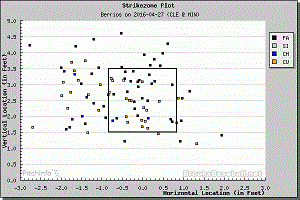Spring training is a time of position battles, football-style jersey numbers and players in the best shape of their lives, but it's also a great time to look at what some pitchers have been working on during the offseason. I find the pitching mechanics of spring fascinating, as they can provide a glimpse into the future by revealing pitchers who have made major adjustments or those who struggle to get into game-shape in time for the regular season.
We have to be careful when evaluating spring mechanics, as a pitcher who struggles to maintain balance, is low on power or struggles with repetition early in camp simply may be shaking off rust or building functional strength after an offseason of golf, such that the mechanical differences are subject to conditioning rather than an intentional adjustment to his delivery. On the other hand, it's exciting when a pitcher shows improvements in March, with more efficient mechanics than seasons' past, which can indicate that the adjustments will stick into the regular season and precipitate a spike in performance.
I tend to focus on players who struggled with particular mechanical quirks last season to see if the problem areas have been addressed, while other times my eye catches an adjustment when watching spring training games (or the WBC).
In this series for Pitching 3D, we'll take a look at pitchers who have made changes to their deliveries, discuss the implications of those changes and how they can impact their fantasy stats. Pitching
Spring training is a time of position battles, football-style jersey numbers and players in the best shape of their lives, but it's also a great time to look at what some pitchers have been working on during the offseason. I find the pitching mechanics of spring fascinating, as they can provide a glimpse into the future by revealing pitchers who have made major adjustments or those who struggle to get into game-shape in time for the regular season.
We have to be careful when evaluating spring mechanics, as a pitcher who struggles to maintain balance, is low on power or struggles with repetition early in camp simply may be shaking off rust or building functional strength after an offseason of golf, such that the mechanical differences are subject to conditioning rather than an intentional adjustment to his delivery. On the other hand, it's exciting when a pitcher shows improvements in March, with more efficient mechanics than seasons' past, which can indicate that the adjustments will stick into the regular season and precipitate a spike in performance.
I tend to focus on players who struggled with particular mechanical quirks last season to see if the problem areas have been addressed, while other times my eye catches an adjustment when watching spring training games (or the WBC).
In this series for Pitching 3D, we'll take a look at pitchers who have made changes to their deliveries, discuss the implications of those changes and how they can impact their fantasy stats. Pitching mechanics may only be one category on my fantasy SP rubric, but mechanical improvements often have a ripple effect that radiates out to all of the roto categories.
I was all over Berrios entering last season. He's a young pitcher with a powerful delivery and steady command of electric stuff. But after receiving the call to the show in late April, his performance was a disaster from the get-go. He displayed no apparent command of any of his pitches. Everything he threw drifted to the arm-side, far outside to left-handed batters, and though some of the drift was due to ridiculous arm-side movement on his two-seam fastball, the main culprit was rooted in mechanics.
Check out Berrios' pitch plot from his major-league debut, which exposes the extent to which his command had gone haywire:

It was as if Berrios had taken a more typical scattering of dots and shifted it about nine inches to the third-base side of the strike zone. Not only was he constantly missing arm-side, but he had a hell of a time trying to hit the glove-side of the plate (inside to left-handed batters). The following clip provides a good example of an all-too-common scenario in his debut:
Mechanically, there were two major issues contributing to his right-leaning pitch trajectories. First, his stride was directed off-line, veering toward the right-handed batter's box, a misalignment that made it especially difficult to hit the left side of the plate because he needed to over-rotate past ideal extension at release point to hit those spots. Secondly, his timing was completely compromised, with an unnecessarily quick pattern of lift-and-stride that completed the lower-half portion of his delivery before the upper-half was prepared to throw.
The result was a late arm that struggled to catch up to the rest of his body, such that his arm had yet to reach full extension by the time the ball left his hand. It's a common scenario, resulting in a pitch that misses its target high and to the arm-side of the target, but pitchers rarely show such a consistent mid-click to the gears of their delivery. It also made it nearly impossible to hit glove-side (left hand) targets, because the arm didn't have time to reach full extension, let alone continue rotating past ideal the release point in order to achieve the over-rotation necessary to hit those left-side targets.
The misalignment with his target is a relatively easy fix, but timing issues can take much longer to iron out. In order to diagnose timing patterns (good and bad), I use a stopwatch to record the time from when the pitcher lifts his front (lift) foot off the ground to the moment it comes back down into footstrike. In the above clip from Berrios' debut, this lift-and-stride timing was 0.75 seconds, a relatively fast time considering that typical pitchers fall within 0.95-1.05 seconds for this measure.
Berrios has strong momentum with great speed down the hill, attributes for which I have praised him in the past, but a pitcher with big momentum doesn't necessarily need to have such a fast time-pattern with lift and stride. The key to extending that time, allowing the arm to catch up and prepare to trigger after foot strike, is a pitcher's leg lift. By lifting the leg higher (or drifting it further back toward second base, as is the case with some hurlers), a pitcher can continue to reap the rewards of strong momentum by charging forward for a longer time before the foot hits the ground.
Berrios continued to struggle with these same mechanical headaches throughout the 2016 season at both the major- and minor-league levels. However, he seemed to figure things out at the very end of the season. Check out his pitch plot from his final start of the year:

There are still several pitches that missed wide of the zone to the arm-side (the left side of the graphic), but he also peppered the glove-side, including a half-dozen offerings that were right on the left-hand edge of the strike zone. Most impressive to me are the splattering of dots in the lower-right corner of the zone, indicating his ability to manipulate locations both before and after full extension. The game prior to this October outing featured more of his season-long struggles with arm-side misses, so this start signified a level of command that had alluded him for the entire season.
Watching the WBC this year, I was naturally curious to see if the lessons of that last game would carry over for Berrios, or if he would resort back to his old shenanigans. For the record, I hadn't seen any evidence of the issue in the minors prior to 2016, so it may have been a single-year lapse of mechanical efficiency, but I wouldn't really know until he took a mound this season. Well, in the WBC championship, Berrios (pitching for team Puerto Rico) showed Team USA a much more fluid, powerful and consistent delivery than shown 2016:
(P.S. Isn't that just a nasty slider? Pure filth.)
For starters, Berrios' stride was aimed more directly at the target and toward the plate, rather than the closed-off version of his stride that was directed toward the right-hand batter's box. His momentum was powerful, and it continued to flow toward the plate after release point, a clear indicator of his improved efficiency. He also had more time for lift-and-stride, taking 1.05 seconds in the above clip between the moment when the front foot lifts off the ground to the moment it touches down again into footstrike.
The extra time wasn't due to a slower delivery but rather a higher leg lift and a longer stride pattern into footstrike, enabling Berrios to extend his stride even farther by taking advantage of his impressive momentum to get closer to the plate and to find a timing pattern that allowed his throwing arm to reach full extension. The WBC game wasn't totally clean, as Berrios surrendered three earned runs in 1.2 innings of the WBC final, but it's worth noting that four of the five outs were registered via the strikeout.
I'm not saying that every pitcher should take longer from lift to foot strike, but in the specific case of Berrios, the 0.75-second timing pattern from 2016 was too quick with the lower half and didn't let the throwing arm catch up with the kinetic sequence (when everyone misses up and arm-side), but the WBC version of his delivery (1.05 seconds) allowed Berrios to create a more repeatable trigger of trunk rotation with greater torque than in the past, as he let the hips gain separation after foot strike, rather than pulling said trigger as soon as the front foot hit the ground.
Timing is the most critical element in a pitcher's mechanics, and Berrios' improvement in that department will allow him to lower his walk rate through more predictable pitch locations and up the ante of velocity due to the increased torque from a well-timed delivery. Combined with the improved positioning, the 1.05-second timing pattern could inspire a spike to all four of his relevant roto stats.
The adjusted timing pattern not only gives his throwing arm a chance to catch up to the rest of his body, but it also paves the way for Berrios to line up the gears and maximize hip-shoulder separation. In the WBC clip, his foot hits the ground and there is a distinct delay before he triggers trunk rotation, allowing Berrios to complete each phase of the kinetic chain rather than rush the process in an attempt to find a release point, with the start of his trigger occurring right on top of foot strike as was often the case last season.
Berrios is back online and ready to troll the folks who gave up on him too soon, delivering on the value proposition that he seemed to promise in the 2016 campaign. I count myself among the haters, in the sense that Berrios didn't even make my top-88 when ranking fantasy pitchers for this season. He just missed my ranks, but a few tweaks to his projected innings and ratios and he's suddenly worth owning and continues to carry the upside of an impact starter in fantasyland. It looks like it's time to add some helium to his ranking in my system.



























